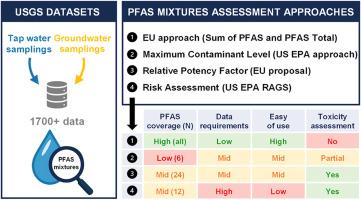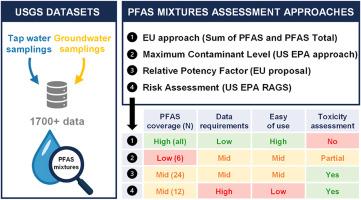基于大量自来水和地下水数据的四种PFAS混合物评价方法的比较
IF 7.3
2区 环境科学与生态学
Q1 ENVIRONMENTAL SCIENCES
引用次数: 0
摘要
全氟和多氟烷基物质(PFAS)是广泛存在于饮用水系统中的持久性有毒污染物。全球的监管反应各不相同,越来越需要采用基于科学的方法来评估全氟磺酸混合物造成的健康风险。然而,现有的研究主要依赖于孤立的理论例子或小数据集,使得这些方法的现实意义难以理解。本研究通过应用来自美国地质调查局进行的大规模PFAS监测活动的两个高质量数据集,解决了这一差距,四种领先的PFAS混合物评估方法:(i)基于总PFAS阈值和20个特定PFAS总和的欧盟方法;美国环境保护署规定的最大污染物水平;(iii)欧盟正在评估的相对效力因子法;(iv)风险评估(u.s. EPA RAGS)方法。这些数据集涵盖了1700多个地下水和自来水样本,为研究每种方法的实际差异和后果提供了坚实的基础。结果显示不同方法之间存在显著差异。欧盟的方法虽然适用于所有样品,但没有考虑到个别化合物之间的毒理学差异,往往低估了对健康的影响。最大污染物水平方法提供了一种更基于健康的评估,尽管它只适用于一部分化合物。相比之下,相对效力因子和风险评估(美国环保局RAGS)方法提供毒性加权评估,提供更可靠和一致的健康风险表征。值得注意的是,只有风险评估(u.s. EPA RAGS)评估了全氟辛烷磺酸和全氟辛烷磺酸的致癌性影响,尽管其估计依赖于不断发展和有争议的毒理学假设,需要谨慎解释。这些发现强调了方法选择如何影响PFAS风险评估,为未来的环境政策和风险评估实践提供了有用的见解。本文章由计算机程序翻译,如有差异,请以英文原文为准。


Comparison of four PFAS mixtures assessment approaches based on extensive tap water and groundwater data
Per- and polyfluoroalkyl substances (PFAS) are persistent and toxic contaminants widely detected in drinking water systems. Regulatory responses have varied globally, with a growing need for science-based approaches to assess the health risks posed by PFAS mixtures. However, existing studies have mainly relied on isolated theoretical examples or small datasets, leaving the real-world implications of these approaches poorly understood. This study addresses this gap by applying to two high-quality datasets from large-scale PFAS monitoring campaigns conducted by the USGS four leading PFAS mixtures assessment approaches: (i) the EU approach based on thresholds for total PFAS and the sum of 20 specific PFAS; (ii) Maximum Contaminant Levels established by the US EPA; (iii) the Relative Potency Factor method under evaluation in the EU; and (iv) the Risk Assessment (US EPA RAGS) approach. These datasets cover more than 1700 groundwater and tap water samples, providing a robust basis to investigate the practical differences and consequences of each method. Results reveal significant discrepancies across methods. The EU approach, although applicable to all samples, does not consider toxicological differences among individual compounds, often underestimating health impacts. The Maximum Contaminant Levels approach offers a more health-based evaluation, though it applies to only a subset of compounds. In contrast, the Relative Potency Factor and Risk Assessment (US EPA RAGS) methods provide toxicity-weighted evaluations, offering a more robust and consistent characterization of health risks. Notably, only the Risk Assessment (US EPA RAGS) evaluates carcinogenicity effects in the PFOA and PFOS assessment, though its estimates rely on evolving and debated toxicological assumptions, requiring cautious interpretation. These findings underscore how methodological choices influence PFAS risk evaluation, offering useful insights for future environmental policy and risk assessment practices.
求助全文
通过发布文献求助,成功后即可免费获取论文全文。
去求助
来源期刊

Environmental Pollution
环境科学-环境科学
CiteScore
16.00
自引率
6.70%
发文量
2082
审稿时长
2.9 months
期刊介绍:
Environmental Pollution is an international peer-reviewed journal that publishes high-quality research papers and review articles covering all aspects of environmental pollution and its impacts on ecosystems and human health.
Subject areas include, but are not limited to:
• Sources and occurrences of pollutants that are clearly defined and measured in environmental compartments, food and food-related items, and human bodies;
• Interlinks between contaminant exposure and biological, ecological, and human health effects, including those of climate change;
• Contaminants of emerging concerns (including but not limited to antibiotic resistant microorganisms or genes, microplastics/nanoplastics, electronic wastes, light, and noise) and/or their biological, ecological, or human health effects;
• Laboratory and field studies on the remediation/mitigation of environmental pollution via new techniques and with clear links to biological, ecological, or human health effects;
• Modeling of pollution processes, patterns, or trends that is of clear environmental and/or human health interest;
• New techniques that measure and examine environmental occurrences, transport, behavior, and effects of pollutants within the environment or the laboratory, provided that they can be clearly used to address problems within regional or global environmental compartments.
 求助内容:
求助内容: 应助结果提醒方式:
应助结果提醒方式:


